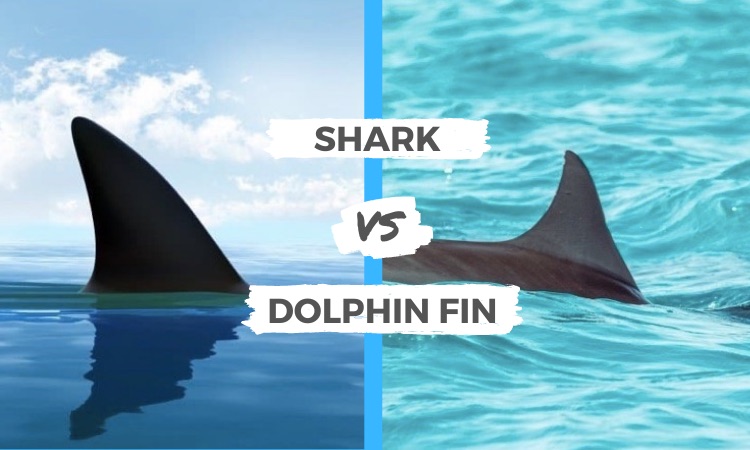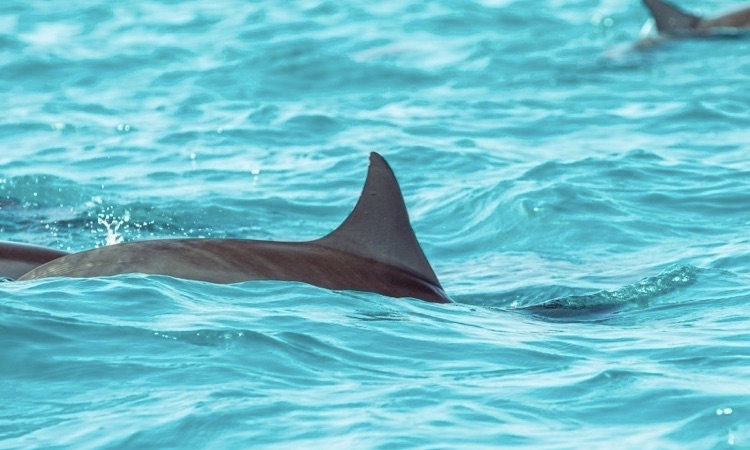An ominous shark fin slicing through the water in the direction of swimmers puts everyone on edge. Occasionally, however, the reported shark is nothing more than a playful or curious dolphin.
Even though shark and dolphin fins have some qualities in common, a closer examination reveals which species of creature is swimming nearby. Read on to learn the differences between a shark vs dolphin fin.

Shark vs Dolphin Fin: Main Differences
Let’s explore the main differences between a shark fin vs dolphin fin.
Shark Fins
The main edge of a shark fin is slanted, while the trailing edge is straight. The sharks’ dorsal fins are large and stick straight out from the back.
A shark fin has a distinct notch at the base of the spine that separates the rear portion of the fin from the back.
Sharks have between two and four unpaired fins on their bodies, depending on the species. The water must be less than one meter deep for the second dorsal fin to become visible.
It’s smaller than the first dorsal fin, so you need to scrutinize it more closely in order to identify it.
A shark’s second fin is similar to a fish. Sharks have a tall, vertical tail that flutters from one side to the other.
When it comes to their dorsal fins, there is a significant difference between the Shark vs Dolphin Fin. Some dolphin species have rounded dorsal fins, while sharks have straight tail ends on theirs.
The shape of shark fins is usually triangular. Depending on the species, the leading edge of the dorsal fin has a small curve and the back edge points in the direction of the tail, which is square or flat.
On the beach, however, it is sometimes difficult to tell the difference between rounder fins and square ones in shark species such as the hammerhead shark.
The dorsal fin that breaks the water’s surface is accompanied by a tiny tail fin a few meters above sea level, providing evidence of a shark sighting.
The tail and tail fin in sharks break through the surface of the water, and the animal is upright at both ends. The hammerhead shark’s dorsal fin has rounded rather than bent or hook-shaped ends.
The triangular dorsal fin provides enough warning. Small sharks, which are common in beaches, lack a tail fin but have visible tails. The bigger the shark fins get, the more they look alike and differ from dolphins.
Sharks eat in the surf and are typically solitary. If there are a lot of sharks in an area, they do not usually swim together.
Sharks typically move forward in a constant motion, so you can be sure they’re not belly-flopping about like a dolphin in a wave. When they move, it’s likely that the dolphin must break through the surface to breathe.

Dolphin Fins
When comparing a Shark vs Dolphin Fin, the way dolphins and sharks move through the water with their visible fins differs.
The tails of dolphins and sharks have an infinite amount of control, but their approach in the water is quite different. As they swim, dolphins have a broad horizontal tail. The bow and curved tip of a dolphin’s dorsal fin are distinctive.
Dolphins congregate in small groups, but sharks are solitary predators. You’re more likely to see more than one dolphin when you observe one.
Some have said that recent sightings of dorsal fins might have come from manta rays or whales, but specialists disagree.
In the viewpoint of manta rays, two fins emerge from the water parallel to one another, and they are significantly smaller than shark or dolphin fins.
Whales can frequently be seen on beaches without fins, and their entire body occasionally breaks through the water’s surface. They spray out of their orifices if it’s a whale, and they are generally larger.

Shark Fin vs Dolphin Fin: Other Differences
Aside from the Shark vs Dolphin Fin, there are many other distinctions. Sharks have gills on both sides of their bodies, whereas dolphins have holes in their heads.
Dolphins and sharks have a dorsal fin on their backs, as well as two flippers on each side and tail. Sharks and dolphins also have a counter-shadow on their bellies that illuminates their backs, allowing them to blend in with the marine environment.
The tails of sharks are vertical, so they’re used when swimming laterally, whereas the tails of dolphins are horizontal and are utilized while swimming vertically up and down.
Dolphins are famous for being vocal and sociable. Megapods, superpods, and lone individuals known as pods travel together in groups.
Sharks are quiet and lonely, unlike dolphins. The social behaviour of sharks is not as well studied as that of dolphins.
Sharks and dolphins are opportunistic feeders. They consume whatever is available and easy for omnivores to hunt, whether it be fish, crustaceans, cuttlefish, or shrimp. Their cuisine includes anything from fish to crabs to squid.
Shrimp make up a significant portion of the shark’s diet, however, different types of sharks eat different types of sea creatures. Large sharks like Great Whites have a penchant for sea mammals like sea lions and seals.
Dolphins require access to the surface in order to breathe air, but sharks spend their entire lives underwater, known as the open ocean, shallow coastal areas, coral reefs, and in some cases rivers.
When you’re on the beach or in the sea, you may be afraid of seeing a grey fin on the water’s surface. You might have an idea what it is if you pay attention. However, if you’re not sure, it’s best to leave it alone and avoid attempting to swim over to find out.



